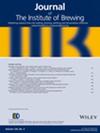下载PDF
{"title":"全面分析和感官分析的非酒精啤酒和他们的淡啤酒的对手","authors":"Jeroen Bauwens, Filip Van Opstaele, Lore Eggermont, Florian Weiland, Barbara Jaskula-Goiris, Gert De Rouck, Jos De Brabanter, Guido Aerts, Luc De Cooman","doi":"10.1002/jib.664","DOIUrl":null,"url":null,"abstract":"<p>In this study, the major differences between commercial pale lager beers (PLB) and their non-alcoholic (NAB) counterparts were characterised by chemical-analytical and sensory analysis. Chemical-analytical profiling was performed using standard brewery analyses in addition to gas and liquid chromatography for quantifying volatile and non-volatile compounds. NAB differed in analytical composition from the PLB, in sugar, aroma, and amino acid profiles. Generally, the PLB contained higher levels of volatile aroma constituents (in particular, significantly higher levels of 2-methylbutan-1-ol, 3-methylbutan-1-ol, ethyl acetate, ethyl hexanoate and ethyl octanoate), specific amino acids (including cysteine, glutamine and alanine), sulphite, glycerol and proteins. NAB show significantly higher concentrations of fermentable sugars (maltose, glucose, fructose and maltotriose), as well as higher levels of amino acids (including threonine, serine and asparagine) and <i>trans</i>-2-nonenal. The PLB was similar in analytical composition, whereas the NAB could be discriminated into two clusters, reflecting different sugar profiles, reflecting the production technology. Organoleptic assessment described the flavour of the NAB as ‘worty’, ‘sweet’ and ‘watery’, while the PLB scored higher in ‘bitterness intensity’ and ‘fullness’. Interestingly, those NAB where the analytical profile differed the most from their PLB counterparts exhibited the largest differences in sensory properties. Furthermore, this study suggests synergistic and/or antagonistic effects between groups of chemical compounds which may explain the flavour differences. For instance, high sugar levels suppress the perception of bitterness, whereas sugars, aldehydes and esters impact on the worty flavour of NAB. © 2021 The Institute of Brewing & Distilling</p>","PeriodicalId":17279,"journal":{"name":"Journal of The Institute of Brewing","volume":null,"pages":null},"PeriodicalIF":2.4000,"publicationDate":"2021-07-19","publicationTypes":"Journal Article","fieldsOfStudy":null,"isOpenAccess":false,"openAccessPdf":"https://sci-hub-pdf.com/10.1002/jib.664","citationCount":"6","resultStr":"{\"title\":\"Comprehensive analytical and sensory profiling of non-alcoholic beers and their pale lager beer counterparts\",\"authors\":\"Jeroen Bauwens, Filip Van Opstaele, Lore Eggermont, Florian Weiland, Barbara Jaskula-Goiris, Gert De Rouck, Jos De Brabanter, Guido Aerts, Luc De Cooman\",\"doi\":\"10.1002/jib.664\",\"DOIUrl\":null,\"url\":null,\"abstract\":\"<p>In this study, the major differences between commercial pale lager beers (PLB) and their non-alcoholic (NAB) counterparts were characterised by chemical-analytical and sensory analysis. Chemical-analytical profiling was performed using standard brewery analyses in addition to gas and liquid chromatography for quantifying volatile and non-volatile compounds. NAB differed in analytical composition from the PLB, in sugar, aroma, and amino acid profiles. Generally, the PLB contained higher levels of volatile aroma constituents (in particular, significantly higher levels of 2-methylbutan-1-ol, 3-methylbutan-1-ol, ethyl acetate, ethyl hexanoate and ethyl octanoate), specific amino acids (including cysteine, glutamine and alanine), sulphite, glycerol and proteins. NAB show significantly higher concentrations of fermentable sugars (maltose, glucose, fructose and maltotriose), as well as higher levels of amino acids (including threonine, serine and asparagine) and <i>trans</i>-2-nonenal. The PLB was similar in analytical composition, whereas the NAB could be discriminated into two clusters, reflecting different sugar profiles, reflecting the production technology. Organoleptic assessment described the flavour of the NAB as ‘worty’, ‘sweet’ and ‘watery’, while the PLB scored higher in ‘bitterness intensity’ and ‘fullness’. Interestingly, those NAB where the analytical profile differed the most from their PLB counterparts exhibited the largest differences in sensory properties. Furthermore, this study suggests synergistic and/or antagonistic effects between groups of chemical compounds which may explain the flavour differences. For instance, high sugar levels suppress the perception of bitterness, whereas sugars, aldehydes and esters impact on the worty flavour of NAB. © 2021 The Institute of Brewing & Distilling</p>\",\"PeriodicalId\":17279,\"journal\":{\"name\":\"Journal of The Institute of Brewing\",\"volume\":null,\"pages\":null},\"PeriodicalIF\":2.4000,\"publicationDate\":\"2021-07-19\",\"publicationTypes\":\"Journal Article\",\"fieldsOfStudy\":null,\"isOpenAccess\":false,\"openAccessPdf\":\"https://sci-hub-pdf.com/10.1002/jib.664\",\"citationCount\":\"6\",\"resultStr\":null,\"platform\":\"Semanticscholar\",\"paperid\":null,\"PeriodicalName\":\"Journal of The Institute of Brewing\",\"FirstCategoryId\":\"97\",\"ListUrlMain\":\"https://onlinelibrary.wiley.com/doi/10.1002/jib.664\",\"RegionNum\":3,\"RegionCategory\":\"农林科学\",\"ArticlePicture\":[],\"TitleCN\":null,\"AbstractTextCN\":null,\"PMCID\":null,\"EPubDate\":\"\",\"PubModel\":\"\",\"JCR\":\"Q3\",\"JCRName\":\"FOOD SCIENCE & TECHNOLOGY\",\"Score\":null,\"Total\":0}","platform":"Semanticscholar","paperid":null,"PeriodicalName":"Journal of The Institute of Brewing","FirstCategoryId":"97","ListUrlMain":"https://onlinelibrary.wiley.com/doi/10.1002/jib.664","RegionNum":3,"RegionCategory":"农林科学","ArticlePicture":[],"TitleCN":null,"AbstractTextCN":null,"PMCID":null,"EPubDate":"","PubModel":"","JCR":"Q3","JCRName":"FOOD SCIENCE & TECHNOLOGY","Score":null,"Total":0}
引用次数: 6
引用
批量引用


